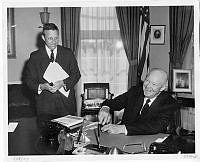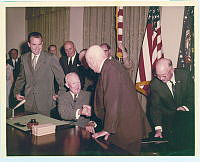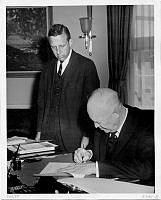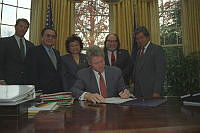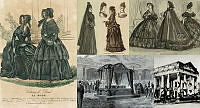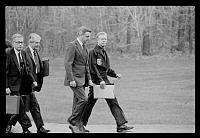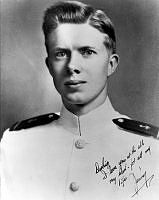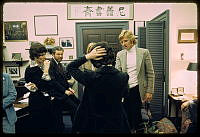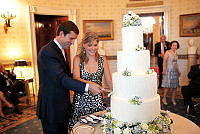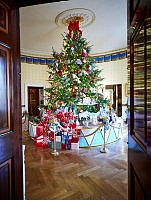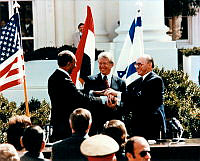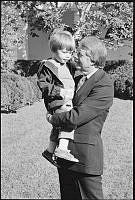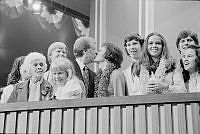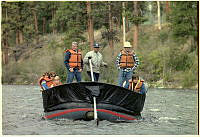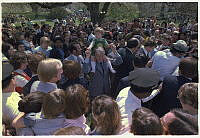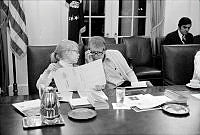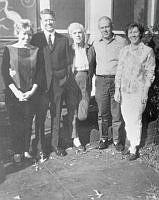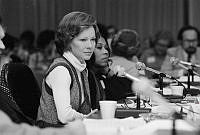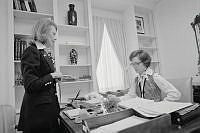Platform Star
Robert G. Ingersoll in Washington
Copyright © Summer 2012 White House Historical Association. All rights reserved under international copyright conventions. No part of this article may be reproduced or utilized in any form or by any means, electronic or mechanical, including photocopying, recording, or by any information storage and retrieval system, without permission in writing from the publisher. Requests for reprint permissions should be addressed to books@whha.org
During the last three decades of the nineteenth century, Americans were entertained, challenged, educated, and even shocked by an orator who crisscrossed the country by train, delivering more than 1,300 lectures and campaigning successfully for Republican Party presidents and politicians. He was heard by more Americans than any other person before the invention of the radio. His close friend, Walt Whitman, considered him the voice of the age. He has been called “the most remarkable American most people never heard of.”1 Between 1878 and 1885 Colonel Robert Green Ingersoll lived in Washington, D.C., the first five of those seven years at 25 Lafayette Square,2 a short walk from the White House, where he often visited with and advised Presidents Rutherford B. Hayes, James A. Garfield, and Chester A. Arthur.
Born to a traveling preacher in Dresden, New York, in 1833, Ingersoll grew up with little formal education. Yet he was endowed with curiosity and a quick mind, and he read widely, becoming a schoolteacher for a short time in 1852.3 He served in the Union Army, helping raise the Eleventh Illinois Volunteer Cavalry regiment in 1861, in which he later served as colonel. In February 1862, just before his regiment was deployed, he married Eva Parker of Peoria, Illinois. He saw action in the Tennessee Valley Campaign at Shiloh and Corinth before he was captured then released, paroled, and discharged in 1863.
Choosing the law as a career when he was 21 years old, Ingersoll took the bar exam with his older brother, Ebon, in Illinois, where they started a law practice. The partnership and close friendship continued until 1879, when Ebon died suddenly in Washington of a heart attack after serving three terms in Congress (1864–71) as representative of the Illinois Fifth District.4 Possessed of a quick and logical mind, an eidetic memory, and good speaking skills, and at ease before a crowd, Robert Ingersoll succeeded brilliantly as a lawyer.5 He earned a good living by representing clients in the burgeoning railway industry, but he also represented clients in divorce cases, estate wills, and criminal cases.
Ingersoll earned national fame in the Star Route trials of 1882–83, in which, in the District of Columbia Criminal Court, he led a team of seven lawyers in successfully defending Senator Stephen Dorsey of Arkansas and seven others against charges of corruption brought by the U.S. attorney general. The trial lasted six months, and Ingersoll’s closing arguments lasted six days—all delivered without notes. During his career he also argued many cases before the U.S. Supreme Court.6 He and his brother shared a law office at 1417 G Street NW, near the Treasury Building. After his brother’s death, Ingersoll moved his office a block away, to 1421 New York Avenue NW.
Ingersoll’s home on the east side of fashionable Lafayette Square was a large brick town house. The larger of two built around 1872, it had been occupied by Senator William Windom from 1872 to 1875 (7) and abutted the house occupied by Dolley Madison in the 1840s. It would be later acquired by the Cosmos Club and taken down in 1909 to allow for expansion of the club’s facilities.8 Number 25 Lafayette Square was ample enough to accommodate Ingersoll’s large household of twelve: nine family members and three African American servants. They included Robert and his wife Eva and their two teenage daughters, Eva and Maud; his mother-in-law Harriett Parker; his wife’s sister, Sue Parker Farrell, with her husband, Clinton Farrell, and their baby; Sue Sharkey, who was engaged as a nurse-nanny-housekeeper by the Ingersolls when their daughters were young and who stayed with, and was considered part of, the family for many years; and three servants—William Vaughn, Georgie Brown, and Fanni Evans.9
In a series of articles in the Republic Magazine entitled “Celebrities at Home,” the exterior of the home was described in the June 27, 1880, issue as follows:
"This great orator, advocate, free thinker (and shall I say atheist?) lives on a square made famous in the last twenty odd years. His house is a large brick with heavy brownstone trimmings, very deep and broad, with generous halls and big, square rooms. Fronting the house is the beautiful Lafayette Park, with its rare foliage, and within a stone’s throw is the White House."
The interior was also described:
"The house of Colonel Ingersoll is almost new, and although not built for him, seems to have been fashioned for him. The main hall is very wide, the floor is one of marble, and arches lead to the stairway, to the dining room and to the parlors. An immense mirror in gilt frame on a marble base, two highbacked chairs of carved walnut and the ordinary hall furniture may be seen as you enter from the vestibule. A copy of Page’s bust of Shakespeare is on the marble stand of the mirror, and the walls are hung with allegorical figures in photography. The first door to the left as you enter is the library. The furniture is of velvet, a table covered with books is in the centre of the room and book-cases line the walls. The library is not large nor does it specially indicate the character of the owner. It is complete, no doubt, in the standard works of prose and poetry, and the owner’s bent may possibly be guessed from the very full editions of Voltaire, Hobbs, Bacon, John W. Draper, Helmholtz, Haeckle, Buckner, Fichte, Schopenhauer and most of the other philosophers. Shakespeare is everywhere in this house. He is the acknowledged god and the only god worshipped. Rows of shelves are devoted to the matchless poet, and pictures of him are everywhere."
Finally, the article described Ingersoll himself:
"Personally Colonel Ingersoll is the most charming of men, and, as a natural consequence, his life is blameless; for one holding his particular views of life and death could not dwell in peace in a religious community if there was a taint on his private life and walks. He keeps away from bar-rooms, he never utters a profane word, he gives liberally to all good works, whether Catholic, Methodist, Baptist or what not; his word is taken by everybody who ever had dealings with him, and nobody who has ever known him would ever ask for his bond. His house is the ideal Liberty Hall. . . . He is never without company. His family consists of his wife, “a woman without superstition,” and two daughters, Eva, aged 16, and Maud, aged 15. He says his children never did a wrong in their lives, and they never had a secret from their parents. They, too, do exactly as they please. They were never reprimanded or refused a request in their lives."10
The Ingersoll house was always alive and busy with the comings and goings of guests, politicians, and artists. on most Saturday or Sunday evenings, it was the setting for the famous “At Homes,” attended by the most glamorous, powerful, and interesting Washingtonians of the day. The Ingersolls received diplomats, members of Congress, department heads, judges, writers, actors, musicians, and notables such as Frederick Douglass and Clara Barton. Ingersoll’s biographer recorded that “men of national and international reputation—prominent members of the House and of the Senate, members of the Cabinet, etc. invariably formed part of the circle of which the great orator was the magnetic center. During ‘presidential years,’ it was not unusual to find in the Ingersoll drawing-room a half-dozen prospective candidates for the presidency, absorbed in the discussion of current political questions.”11 These soirees were so popular and regular that when the Ingersolls left town for a period of time, an announcement in the local newspaper informed the public: “It is announced that the Saturday evening receptions of Colonel and Mrs. Ingersoll and their accomplished relatives, Mrs. Eben C. Ingersoll and Miss Mamie, her daughter with Mr. and Mrs. Farrell, will be discontinued for the present, but will be resumed a little later in the season.”12
On February 13, 1883, the Ingersolls celebrated their twenty-first wedding anniversary with a party at their home on Lafayette Square. “More than 400 guests were present,” the New York Times reported, “many of them having first attended the reception at the White House. The four parlors of the house were decorated with palms and flowers and an elaborate supper was served.” The White House reception had been hosted by President Arthur, explained the paper, as “a brilliant social farewell to the Forty-seventh Congress.”13
Ingersoll’s connection and influence with Washington’s political power structure were significant. Besides connections through his brother, Ebon, the congressman, Ingersoll campaigned for many successful Republican presidential and congressional candidates. After Garfield was elected, a half-hour parade by the Garfield-Arthur Club of Washington, preceded by a section of the Marine Band, ended “with a celebration and serenade at the brightly lighted and decorated home of the Ingersolls.”14
Ingersoll was on particularly close terms with President Garfield, whom he saw just before and after the assassination. As Ingersoll’s biographer recorded:
"On July second Ingersoll spent the evening from eight to ten in conference with Garfield. In the morning, when they were to resume discussion, Ingersoll was late, driving up at the White House just in time to greet the president on his way to the trains to keep an out-of-town engagement. Ingersoll returned home. Some fifteen minutes later there were cries in the street: “The President has been shot! The President has been shot!” Hurrying to the depot Ingersoll was admitted to the upstairs room where the wounded president lay stretched out on the floor. Garfield recognized Ingersoll, they exchanged a few words, and Ingersoll returned home."15
In addition to being a successful lawyer and political campaigner, in the 1860s Ingersoll began delivering lectures and speeches. They received good reviews from the local press, and ticket sales began to be significant. As his lecturing began to overtake his “lawyering,” a third career emerged. Eventually Ingersoll delivered more than 1,300 lectures, traveling by train to speak before packed houses in all the states of the Union except Alabama and South Carolina. Some thirty repeatedly delivered lectures constitute the first four volumes of a twelve-volume set of his works. The other volumes include his many press interviews, newspaper articles, essays, legal arguments, eulogies, and tributes. The official Dresden Edition of his works, named for his birthplace in Dresden, New York, on Lake Seneca, was published by his brother-in-law, Clinton P. Farrell, in 1899.
Ingersoll’s positions on most issues of the day were progressive and forward thinking. He advocated for women’s rights, children’s rights, birth control, racial equality, voting rights for women and for citizens of the District of Columbia, science and Darwin’s theory of evolution, and the rehabilitation of criminals. His opinions, and his reasons for them, were sought by journalists wherever he traveled. He was a staunch defender of what today is called family values and opposed to pornography. In fact, he resigned from his elected post as president of the Liberal League in opposition to the organization’s position of advocating the right to send pornography through the U.S. mails.
Ingersoll’s most popular, memorable, and scandalous lectures challenged the religious orthodoxy of his day. In the 1870s he became more frank and outspoken with his ideas about religion, the Bible, and the clergy. Raised by a devout and very strict itinerant Congregationalist preacher in northwestern New York state, he had bad memories of the pious and spartan Sabbaths of his youth and particularly objected to the message of hell and damnation to be suffered by all who were not adequate followers of the “one and only true religion.” His religious doubts were encouraged by his wife, Eva, “a woman without superstition,” said the article in the Republic Magazine and the dedication to his collected works.16 By 1872, at age 39, Ingersoll had pretty much liberated himself from orthodox religion. In a lecture entitled “The Gods,” which he delivered twenty-two times over a span of twenty-two years, he was openly critical of the Bible and Christian religious practices and beliefs. Eventually Ingersoll became known as “The Great Agnostic.”
Colonel Ingersoll was a popular speaker in Washington, both when in residence and when he returned on twelve occasions to speak before paying crowds. Of his twenty-three ticketed appearances in Washington, fifteen were at the National Theatre, then still located at 1321 Pennsylvania Avenue NW. He also spoke four times at Lincoln Hall, at Ninth and D Streets NW, and twice at odd Fellows’ Hall at 419 Seventh Street NW.17 The use of odd Fellows’ Hall in 1878 was a last-minute change. The speech had been booked in Lincoln Hall, but the stockholders of that building refused to allow Ingersoll to use their space for what they considered scandalous talks, one titled “Hell” and the other on Thomas Paine. Ingersoll was forced to engage odd Fellows’ Hall instead.18
Ingersoll’s appearance at Lincoln Hall on October 22, 1883, was in response to the Supreme Court’s decision to render the Civil Rights Act of 1875 unconstitutional.19 Ingersoll and others were outraged by the decision and spoke strongly against it. He was introduced to the overflow crowd by Frederick Douglass, then recorder of deeds for the District of Columbia. Ingersoll’s fifty-page presentation was so successfully received that a group of twenty-five citizens, headed by Douglass, begged Ingersoll for a repeat of the address, to which he agreed. Three days later, on October 25, he delivered the address again, at Lincoln Hall.20 It took eighty years before a similar bill, the Civil Rights Act of 1964, repaired the damage wrought by this Supreme Court decision.
Ingersoll’s detractors were continually frustrated by their inability to uncover some aspect of his character or behavior on which to build a scandal. Absent was any opportunity to draft into their service a case of corruption, womanizing, or excessive drinking. His character was impeccable: honest, generous, and patriotic. While traveling, he and his family wrote letters to each other almost daily. Missing each other’s company, they filled their letters with nineteenth-century language of affection and family love.
In 1883 the Ingersolls moved from their rented home on Lafayette Square to a larger home on Franklin Square at 1315 K Street NW.21 Colonel Ingersoll’s years in Washington were a very productive period. He composed several of his most popular lectures, exerted political influence, and expanded his law practice. He was a large figure in the Washington and national scene.
Following the election of a Democratic president—Grover Cleveland—in 1885 the Ingersolls moved to New York City, where they would be closer to his profitable railroad clients and the richer cultural scene. They lived there until Colonel Ingersoll’s death in 1899 from a heart attack. His ashes, along with those of his wife, are buried in Arlington National Cemetery. On the gravestone is inscribed: “Nothing is grander than to break chains from the bodies of men—nothing nobler than to destroy the phantoms of the soul.”22

Few images exist of the house where Robert Ingersoll lived from 1878 to 1883 on the east side of Lafayette Square. Demolished in 1909 to allow for expansion of the Cosmos Club, it appears in a late nineteenth century captioned photograph of the block.

Few images exist of the house where Robert Ingersoll lived from 1878 to 1883 on the east side of Lafayette Square. Demolished in 1909 to allow for expansion of the Cosmos Club, it appears in a drawing published in The Republic in 1880.

A view of Madison Place from H Street, c. 1899. The door to the Ingersoll House is just behind the second tree from the left.

Robert G. Ingersoll, c. 1870–90.

Excerpt from pages in the 1880 U.S. Census provide the name, color, sex, age, relationship, and profession of each of the twelve occupants of Ingersoll’s household at 25 Lafayette Square, which was also known as 15½ Street at that time.

Excerpt from pages in the 1880 U.S. Census provide the name, color, sex, age, relationship, and profession of each of the twelve occupants of Ingersoll’s household at 25 Lafayette Square, which was also known as 15½ Street at that time.

Excerpt from pages in the 1880 U.S. Census provide the name, color, sex, age, relationship, and profession of each of the twelve occupants of Ingersoll’s household at 25 Lafayette Square, which was also known as 15½ Street at that time.

The building of the Washington Monument was completed during Ingersoll’s years at 25 Lafayette Square. Although the Ingersoll home is long gone from Madison Place, the clear view of the monument remains.














